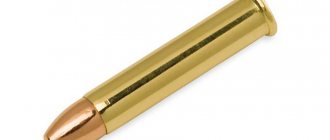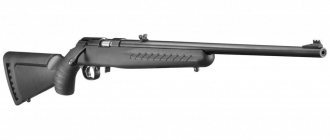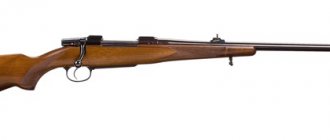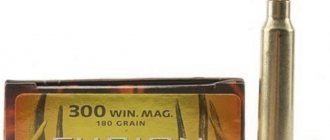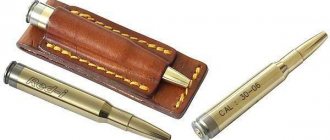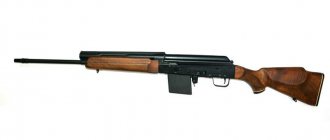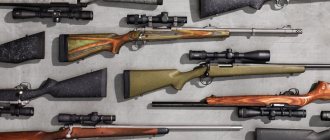About the history of creation
The developer of the 22 WMR caliber was the American arms company Winchester Repeating Arms Company. The cartridge was designed back in 1959, but the company organized mass production in 1960. At this time, they began to manufacture 22 WMR weapons using this ammunition. Soon, other leading American arms companies began producing rifle units for this caliber. According to experts, caliber 22 WMR is the first rimfire cartridge that was mass-produced in the 19th century. Other ammunition of this type appeared only in the 20th century.
Description
22 Mag is somewhat different from other small caliber ammunition. Unlike cartridges 22 Long, 22 Short, 22 Long Rifle, etc., 22 WMR is slightly longer (26.7 mm), and its case has thick walls.
In addition, the sleeve has a larger diameter (6.1 mm). Thus, the use of this ammunition assumes the presence of increased pressure inside the cartridge. For this reason, 22 WMR cannot be equipped with weapons designed to fire other small-caliber cartridges. Otherwise, the rifle unit will become unusable and injure the owner.
At the same time, the 22 WMR caliber weapon is adapted to fire other 5.6 mm ammunition. However, in this case, the shooter may have difficulty extracting an already fired cartridge case. The fact is that if you equip a 22 WMR gun with a short cartridge, the cartridge case will swell and it will be difficult to remove it. For this reason, some manufacturers have started producing replacement drums. As a result, the owner has the opportunity to shoot small-caliber 22 Long, 22 Short, 22 Long Rifle from a gun chambered for 22 WMR caliber. You just need to install the desired drum.
Links[edit]
- Cartridges of the World, 11th Edition
, book by Frank K. Barnes, edited by Stan Skinner, Gun Digest Books, 2006, ISBN 978-0-89689-297-2 pp. 490, 492 - "XT 22 Magnum - 22 Magnum - Armscor International, Inc". armcor.com
. Archived from the original on August 13, 2022. Retrieved April 15, 2022. - "Premium Federal Ammunition - Rimfire". federalpremium.com
. Archived from the original on 2017-12-05. Retrieved December 5, 2017. - "CCI Ammunition - Product Details". www.cci-ammunition.com
. - ^ abc Barnes 1972, p.275, ".22 Winchester Magnum Rimfire".
- Frank S. Barnes. Stan Skinner (ed.). Cartridges of the World
(10th ed.). Krause Publications. ISBN 978-0-87349-605-6. - "CCI Ammo - View All CCI Loads". www.cci-ammunition.com
. - https://www.gunsamerica.com/digest/the-m6-springfield-scout-rifle/ Bring Back the M6 Scout Rifle by JOHN HOADWAY March 5, 2016
- https://www.oldjimbo.com/survival/v-shrake/m6.html M6 Survival System
- "Chiappa Firearm - M6". www.chiappafirearms.com
. Retrieved October 28, 2022. - "Ruger 10/22 Magnum Serial Number History". Product history
. Sturm, Ruger & Co., Inc. Retrieved March 25, 2013. - "Self-Loading Rimfire Rifle - Model 597". Remington Guns
. Remington Arms Company, LLC. Archived from the original on 2013-04-02. Retrieved March 25, 2013. - Słowik, Max (18 January 2012). "EAA Latest Appeal: .22 Long Rifle and .22 Magnum Bullpup Carbines". Blog
. Guns.com. Retrieved March 25, 2013. - CTD Mike (8 March 2012). "EAA Imports New .22 Tanfoglio" Bullpup Carbine Call. Shooters' Journal
. Cheaper than dirt. Archived from the original on April 10, 2013. Retrieved March 25, 2013. - "Taurus Revolver Manual" (PDF). Safety and Operation Guide
. Taurus International. February 25, 2003. Archived from the original (PDF) on January 28, 2013. Retrieved March 25, 2013. - ↑
B. Gil Horman (March 24, 2011).
"North American Arms Mini-Revolvers". American shooter
. Retrieved March 25, 2013. .22 Mag. models can be equipped with a second cylinder chambered in .22 Long Rifle, making practice and shooting truly inexpensive. - "Smith & Wesson Air Lite 351PD (.22 Magnum)". Kansas Kerry
. Custom Digital Services, LLC. 2010. Archived from the original on 2011-03-08. Retrieved March 25, 2013. - NRA Staff (April 22, 2011). Heritage Mfg. Rough Rider Revolvers". American shooter
. Archived from the original on 2013-04-14. Retrieved March 25, 2013. Chambered in .22 Long Rifle and .22 WMR, the nine-shot Rough Rider revolvers from Heritage Mfg. Now available in Blued, Satin Black, Satin Silver and Color. - ↑
Quinn, Jeff (January 5, 2013).
"Ruger LCR 22 Magnum Lightweight and Compact Pocket Revolver". GUNBlast.com
. Retrieved March 25, 2013. I'm glad Ruger includes 22 magnum along with 22 LR, 38 Special Plus P and 357 magnum in this handy little revolver. - ↑
B. Gil Horman (February 15, 2011).
"Kel-Tek PMR-30". American shooter
. Retrieved March 25, 2013. As a fan of the .22 Mag. I'm really pleased that Kel-Tec has built a lightweight, high-capacity semi-auto that demonstrates what this neat little cartridge can do. - ↑
Eger, Chris (7 March 2013).
"Grendel Pistols: Forgotten Polymers (and the Birth of Kel-tec)". Guns.com
. Retrieved March 25, 2013. Thanks to the use of polymers, the weight of this target pistol was reduced to 26 ounces when loaded with an impressive 30 rounds of rimfire ammunition. - ↑
Kelly, Paco (August 9, 2006).
"Still Standing: AMT AutoMag II .22 Magnum Rimfire Auto". GUNBlast.com
. Retrieved March 25, 2013. Not too long ago, AMT (Arcadia Machine & Tool) of Irwindale, California had some very well designed small .22 Magnum pistols available. - ↑
Quinn, Jeff (November 27, 2006).
"High Standard Returns AMT Automag II .22 Magnum Pistol". GUNBlast.com
. Retrieved March 25, 2013. After being out of production for several years, High Standard Manufacturing now produces the Automag II pistol, which was formerly manufactured by AMT in Irwindale, California, and Galena Industries in Sturgis, South Dakota. - "AMT AutoMag". Archived from the original on June 16, 2009.
- ^ ab Lehrmayer, Ralph M. (July 2010). "Evolution .22". GunHunter Magazine
. Buckmasters Ltd. Retrieved September 17, 2016. …Take a .22 rimfire shotgun (like Mossberg or Marlin's Garden pistols) and patterns are surprisingly good out to 15 yards. - "Marlin .22 Mag Garden Gun". fieldandstream.com
. Field and stream. December 1999. Retrieved September 17, 2016. A gopher getter? Get serious. - Jump up
↑ Rees, Clair (March 2000). "Marlin's Garden Gun - Model 25MG". Guns Magazine. Archived from the original on November 7, 2015. Retrieved September 17, 2016. Alternative URL - ↑
Eger, Christopher (28 July 2013).
"Marlin 25MG Garden Gun". Marlin Firearms Forum
. Outdoor Hub LLC. Archived from the original on 2016-09-18. Retrieved September 17, 2016. - ^ abc Barnes 1972, p.275, ".22 Winchester Rimfire (WRF)"
- Sparano, Vin (2000). The Complete Outdoor Encyclopedia
. New York: St. Martin's Press. ISBN 978-0-312-26722-3. - "Remington Magnum Rimfire: 22 Win Mag PR22M1 33-grain AccuTip-V". Remington Arms Company, Inc. Archived from the original on 2008-05-30. Retrieved June 17, 2008.
- "CCI: Varmint 0073 22 Magnum RF V-MAX 30 Point Poly Tip". CCI. Archived from the original on May 16, 2008. Retrieved June 17, 2008.
- "Hornady: 22 WMR 30-grain V-MAX". Hornady Manufacturing, Inc. Archived from the original on 2009-02-10. Retrieved June 17, 2008.
About 22 Mag shells
Unlike other small-caliber ammunition, the 22 WMR does not use lead bullets. In 22 Magnum, the manufacturer is forced to use copper plated. The fact is that 22 WMR is much more powerful. If you shoot a cartridge with a lead unsheathed bullet at a speed of up to 600 m/s, it will fly off the rifling in the barrel channel. Also, due to high friction, it may simply melt. The heads of copper-plated 22 Magnum rounds have expansive cavities. In specialized stores you can also get special 22 WMR cartridges. Their peculiarity is that in place of the bullet there is a capsule, inside of which there is a small shot. This ammunition is effective for shooting rats and mice.
.22 Winchester Magnum Rimfire / .22 WMR cartridge
| .22 WMR |
The .22 Winchester Magnum Rimfire cartridge is designated: .22 Magnum / .22 Winchester Magnum / .22 WMR / 5.6 mm Winchester Magnum RF / XCR 06 027 CBR 010.
The .22 Winchester Magnum Rimfire cartridge of 5.6 mm caliber, often simply referred to as .22 WMR, .22 Win Mag, .22 Magnum or simply .22 Mag, was developed by the American company Winchester in 1959 and quickly became famous as a at home and in Europe.
The overall length of the cartridge is 34 mm, which exceeds the dimensions of the more popular .22 LR cartridge. The .22 WMR also has much larger case sizes.
The larger dimensions of the ammunition allow the use of a larger amount of gunpowder, which in turn, unlike .22 LR, significantly increases the pressure when fired.
The .22 WMR was initially offered with a 40 grain (2.6 gram) bullet with an energy of 439 J and a bullet velocity of 580 m/s. However, .22 WMR cartridges were later developed with bullet weights of 30 and 50 grains (1.9 and 3.2 grams). In this case, the energy of the ammunition is 437 and 410 J, with a bullet speed of 670 and 500 m/s, respectively.
In 1960, the American companies Ruger and Smith and Wesson announced the release of a revolver chambered for this cartridge.
In 1961, Winchester released the M61 lever-action rifle chambered in .22 WMR.
The speed of a bullet depends significantly on the length of the weapon barrel.
So the speed of a bullet when shooting from a pistol is about 460 m/s, and when shooting from a rifle – about 610 m/s. .22 WMR
A huge number of pistols, revolvers, rifles and carbines, mainly hunting ones, designed to use this type of cartridge, were created for the .22 Magnum cartridge.
The advantages of the .22 WMR cartridge include low recoil and low noise levels when fired.
.22 WMR
The effective range of the .22 WMR cartridge is approximately 125 meters.
In addition, depending on the manufacturer, some performance characteristics of the cartridge and its ballistic characteristics vary.
The .22 Winchester Magnum Rimfire cartridge has an elongated cylindrical case. Equipped with shell or expansion bullets.
Bullets weighing 2.6 and 3.2 g have an initial velocity and muzzle energy of 615.511 m/s and 491.425 J, respectively, and at a distance of 100 m: 430.401 m/s and 245.260 J.
The optimal zeroing distance is 100 m. The excess of the flight path of a bullet weighing 2.6 and 3.2 g above the aiming line at a zeroing distance of 100 m is 4.5 and 5.0 cm.
The .22 Win Mag cartridge is one of the few side-fire cartridges that has become most often used for hunting purposes. It can be used for hunting small animals and birds: gophers, marmots, foxes, black grouse, wood grouse, geese.
About the application features
If you compare the 22 WMR with the 22 Long Rifle cartridge, the Winchester is much more powerful. This is explained by the fact that the 22 WMR cartridge case holds one and a half times more powder charge, which significantly affects the combat range. For example, the projectile has a fairly high initial velocity (over 650 m/s), and the effective range varies from 180 to 200 m. Despite the high performance, when firing from a 22 WMR carbine, the recoil is very weak. Judging by the reviews of the owners, it is so minimal that it is not felt at all. The sound of the shot is not loud, which is also highly appreciated by consumers.
Cartridge .22 WMR mod. 1959 What can a “small” magnum do?
Surprisingly, before writing this article, I had never really shot a .22 WMR in Russia.
Moreover, the most I shot with this cartridge was not from a carbine, but from a Kel-Tec PMR-30 semi-automatic pistol - it’s hard to stop when the magazine holds 30 rounds and there’s a box with 500 rounds next to it. I stopped at the second hundred, tired of equipping the magazine... This year is an anniversary year for the .22 Winchester Magnum Rimfire (WMR) cartridge - it was born back in 1959 and has been decorating the shelves of gun stores around the world for 60 years, while remaining rare in Russia exotic. Although there was a time, even “Sable” was made for it. With an eye on the American market, of course...
Despite the digitally similar designation, the .22 WMR cartridge differs from the familiar “small thing” - the .22 Long Rifle (LR) cartridge - primarily differs in a sleeve increased in length and diameter, capable of holding approximately one and a half times the volume of gunpowder. Hence the opportunity to use heavier bullets (up to 3.5 g), increased initial speed (over 600 m/s), as well as both the possibility and necessity (in some cases) of using jacket bullets - at high speeds lead “flows” when moving along the rifling in the barrel and does not provide the necessary stabilization of the bullet at the muzzle.
Hunting carbine Zastava MP22 caliber .22 WMR
In general, what we have before us is still far from a full-fledged centerfire rifle cartridge, but it is no longer a “small thing”, with which modern PCP rifles can compete in terms of muzzle energy. Again, the increased speed and mass of the .22 WMR bullet definitely expand the range of applied ranges for both hunting and training shooting to 150–200 m. From the classic “small gun”, nothing prevents you from hitting the target at such distances, but the steep trajectory and insufficient speed (essentially kinetic energy) in this case turns hunting with .22 LR into a lottery, and when shooting leisurely on paper, wind turns into a real problem.
The .22 WMR cartridge case has a significantly larger internal volume compared to the .22 LR
Anyway. You can calculate the trajectory reduction and kinetic energy at different ranges as much as you like on a ballistic calculator, comparing the characteristics of .22 WMR and .22 LR cartridges, but the fact remains that there is no mass culture of using .22 WMR in Russia.
Eley Force .22 LR cartridge and spent bullets removed from the ballistic block
And where does it come from given the limited choice of budget weapons and the not-so-budget price of .22 WMR cartridges? It’s not that there is no supply, but the counters of gun stores don’t shine with choice either. For example, cartridges with hollow-core bullets are not always and not everywhere available. More often there is a cheaper option with copper plated. But it is with a high-velocity “shell” that the advantage of the .22 WMR over the .22 LR is fully revealed, since the complex design of the bullet provides not only the ability to “accelerate” it, but also better performance for hunting purposes. And we remember that weapons chambered for these cartridges have the same mass and dimensions, and it’s ridiculous to even talk about recoil - there is virtually none in both cases.
Who uses 22 WMR ammunition?
According to experts, 5.6 mm cartridges are ideal for individual shooting training. The good thing about ammunition for training shooting is that it is relatively cheap. Due to the fact that beginners spend a large amount of ammunition during training, their low price is undoubtedly a plus. Due to the increased bullet speed, sports shooting was not an area in which the 22 WMR would be in demand. According to experts, in order to hit the target, the ballistic performance that can be provided by the 22 Long Rifle is sufficient, and not a more powerful cartridge.
For this reason, the manufacturer is focused primarily on hunters. It was they who realized all the strengths inherent in 22 WMR. Judging by the reviews, the Winchester is one of the few rimfire ammunition that is often used for hunting purposes. The targets for shooting are small rodents, rabbits and birds. When using 22 WMR, the hunter should be aware that at close range the projectile can damage the game carcass. If you load the weapon with a bullet that has an expansive cavity, then the muzzle energy of 22 WMR is enough to hit a coyote or jackal.
About weapons for "Winchester"
According to experts, 22 WMR can be fired from carbines, rifles and pistols, the chambers of which are adapted for this ammunition. For example, the Czech-made Varmint CZ 455 rifle unit received a lot of positive feedback.
This carbine can be used to hunt with 22 WMR and 22 LR cartridges. A weapon with an elongated forged barrel and a wooden stock. Detachable magazines are designed for 5 and 10 rounds. The material for making the stock was walnut. The receiver is equipped with a dovetail rail. Its width is 1.1 cm. Thanks to it, you can install an optical sight on the carbine. Price: 45 thousand rubles. For anyone who wants to save money, we can recommend the American-made Marlin 925 hunting carbine. A weapon with a bolt-action system and a wooden stock.
The chamber is adapted for 22 WMR caliber cartridges. Standard sights are represented by an adjustable rear sight and front sight. Additionally, the shooting unit can be equipped with an optical sight. The hunter will have to buy it separately, since the scope is not included in the package. To become the owner of this rifled semi-automatic carbine, you will have to shell out 30 thousand rubles.
